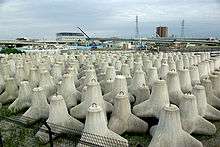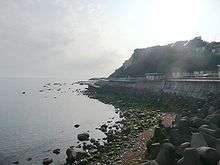Tetrapod (structure)
Tetrapods are a type of structure in coastal engineering used to prevent erosion caused by weather and longshore drift, primarily to enforce coastal structures such as seawalls and breakwaters. Tetrapods are made of concrete, and use a tetrahedral shape to dissipate the force of incoming waves by allowing water to flow around rather than against them, and to reduce displacement by interlocking.[1][2]


Invention
Tetrapods were originally developed in 1950 by Pierre Danel and Paul Anglès d'Auriac of Laboratoire Dauphinois d'Hydraulique (now Artelia) in Grenoble, France, who received a patent for the design.[3] The name was derived from Greek, with tetra- meaning four and -pode meaning foot, a reference to the tetrahedral shape. Tetrapods were first used at the thermal power station in Roches Noires in Casablanca, Morocco, to protect the sea water intake.[4][5]
Adoption
Their success saw Tetrapods become popular across the world, particularly in Japan where their manufacture and dispersal still create jobs and contracts for construction companies. It is estimated that nearly 50 percent of Japan's 35,000 kilometers (22,000 mi) coastline has been covered or somehow altered by Tetrapods and other forms of concrete. The proliferation of Tetrapods on the island of Okinawa, a popular vacation destination in Japan, has made it difficult for tourists to find unaltered beaches and shoreline, especially in the southern half of the island.[6]
Similar designs
The Tetrapod inspired many similar concrete structures for use in breakwaters, including the Modified Cube (United States, 1959), the Stabit (United Kingdom, 1961), the Akmon (The Netherlands, 1962), the Dolos (South Africa, 1963), the Stabilopod (Romania, 1969),[7] the Seabee (Australia, 1978), the Accropode (France, 1981), the Hollow Cube (Germany, 1991), the A-jack (United States, 1998), and the Xbloc (The Netherlands, 2001), among others. In Japan, the word tetrapod is often used as a generic name for wave-dissipating blocks including other types and shapes.[6]
See also
- Artificial reef – A man-made underwater structure, typically built to promote marine life, control erosion, block ship passage, block the use of trawling nets, or improve surfing
- Breakwater (structure) – Structure constructed on coasts as part of coastal management or to protect an anchorage
- Coastal management
- Coastal erosion – The loss or displacement of land along the coastline due to the action of waves, currents, tides. wind-driven water, waterborne ice, or other impacts of storms
- Dolos – Concrete breakwater element
- KOLOS – Concrete breakwater element
- Ocean surface wave
- Riprap
- Seawall – Form of coastal defence
- Xbloc – Concrete breakwater element
References
- "What are Tetrapods? (Tetrapods Resist Wave Impact and Prevent Beach Erosion)". Brighthub Engineering. Retrieved 2017-08-02.
- Park, Sang Kil; et al. (2014). "Effects of vertical wall and tetrapod weights on wave overtopping in rubble mound breakwaters under irregular wave conditions" (PDF). Retrieved 2 August 2014.
- Pierre Danel and Paul Anglès d'Auriac (1963) Improvements in or relating to artificial blocks for building structures exposed to the action of moving water
- Danel, Pierre (1953). "TETRAPODS". Coastal Engineering Proceedings. 1 (4): 28. doi:10.9753/icce.v4.28. ISSN 2156-1028.
- Danel, Pierre (1967). "The Tetrapod". Retrieved 2 August 2017.
- Hesse, Stephen (2007-07-22). "TETRAPODS". The Japan Times Online. ISSN 0447-5763. Retrieved 2017-08-02.
- Spătaru, A (1990). "Breakwaters for the Protection of Romanian Beaches". Coastal Engineering. Elsevier Science Publishers. 14 (2): 129–146. doi:10.1016/0378-3839(90)90014-N.
Further reading
- Lagasse, P.F. (2007). Countermeasures to protect bridge piers from scour. Washington, D.C.: Transportation Research Board. ISBN 978-0-309-09909-7.
- Hesse, Stephen. "The Japan Times environment columnist". Don't You Just Love 'Em ... Tetrapods. The Japan Times. Retrieved 13 May 2011.
- Zimmerman, ed. by Claus (2005). Environmentally friendly coastal protection : proceedings of the NATO Advanced Research Workshop on Environmentally Friendly Coastal Protection Structures, Varna, Bulgaria, 25-27 May 2004 (Online-Ausg. ed.). Dordrecht: Springer. ISBN 978-1-4020-3299-8.CS1 maint: extra text: authors list (link)
- Wijers-HasegawaHesse, Yumi. "Tetrapodistas: Beauty beheld in huge concrete forms". The Japan Times.
- Hesse, Stephen. "Loving and Loathing Japan's Concrete Coasts, Where Tetrapods Reign". The Asia-Pacific Journal: Japan Focus.
| Wikimedia Commons has media related to Tetrapods. |

